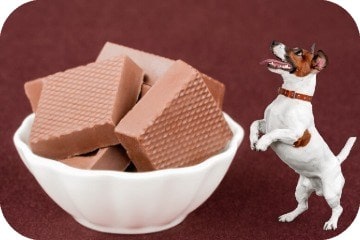Can dogs eat white chocolate? No, no, no! Although white chocolate contains less theobromine (the toxic ingredient) than milk or dark chocolate, it can still cause serious problems in your dog. Due to the low amounts of theobromine, it would take a lot of white chocolate to cause toxic poisoning in your dog.
Busy? Get Your Hands Paws On The Answers Quickly…
- Are Dogs Allowed White Chocolate, Milk Chocolate, or Dark Chocolate?
- Is There Dog-Friendly Chocolate?
- What Should I Do If My Dog Eats White Chocolate?
- What Snacks Can Dogs Eat Instead of Chocolate?
- FAQs
ARE DOGS ALLOWED WHITE CHOCOLATE, MILK CHOCOLATE, OR DARK CHOCOLATE?

No to all types of chocolate! Not only is it toxic for your dog, but chocolate is also very high in fat and sugar. If a dog is consuming high levels of fat and sugar in their diet, it can have serious implications. Serious illnesses or diseases such as heart failure, diabetes, and high blood pressure can occur.
IS THERE DOG-FRIENDLY CHOCOLATE?

Yes! There are a variety of dog-friendly chocolate treats that look and smell like chocolate but do not have the toxic component of theobromine included in the ingredients.
There are a variety of choco dog treats. These are the two most popular;
> Good boy Chocolate Dog Treats
> Chocolate Bar For Dogs
WHAT SHOULD I DO IF MY DOG EATS WHITE CHOCOLATE?

If you think your dog has eaten white chocolate, to be on the safe side, you should call your veterinarian straight away. Although your dog may not have eaten enough of the chocolate for it to become toxic, all dogs react differently, and the smallest amount could still cause some symptoms.
Toxicity Symptoms:
> Dehydration
> Diarrhea
> Extreme Panting/Loss of Breath
> Drooling
> Seizures
> Tremors
WHAT SNACKS CAN DOGS EAT INSTEAD OF CHOCOLATE?
Apple Slices
Apples contain high levels of vitamins A and C. These are delicious and refreshing snacks for your dogs. When frozen, apples are excellent for a dog’s teeth.
Rather than chewing away at a bone or stick, a frozen apple works as well, if not better. As well as this, it also helps to remove any residue of a dog’s teeth, resulting in a better smelling breath!
Apricot Cubes
Apricots themselves are fine for dogs and full of nutrition. They help provide plenty of vitamins and minerals such as; Vitamins A & C, potassium, magnesium, and antioxidants. However, the seeds and other parts of the apricot plant can be harmful or even fatal for your dog! Apricot plants and their seeds contain traces of something called cyanide. When digested by dogs, cyanide prevents the uptake of oxygen by the red blood cells, making it difficult for your dogs to breathe and ultimately can lead to death.
Banana Circles
Bananas are high in potassium, vitamin B6, and vitamin C. Some highly qualified veterinarians recommend this fruit as a natural replacement for shop-bought treats that can be high in fat and calories. However, like with all ‘human’ foods, it should be given to your dog in moderation and ensure they’re not allergic to it.
Bananas are best peeled and sliced for your furry friend; however, if they do eat the skin, you do not need to worry as it is not toxic. Finely slicing the banana into small chunks will help avoid any potential choking.
If you have mentally stimulating dog toys, for example, a kong, you can mush the banana up and put it inside the kong, this works great and keeps your dog occupied for an extended period of time.
Kiwis
Kiwi’s make an excellent snack for your dog. If feeding kiwi to your dog, it is best to remove the skin before doing so as it can be difficult to digest. Kiwis provide your dog with high levels of vitamin C and potassium, which are important nutrients within their diet. Kiwi’s may seem a small fruit for us humans, but a whole kiwi could be too much for a dog. Prepare the kiwi by slicing it into small chunks and feeding around ¼ or ⅓ of the kiwi at a time.
As with all ‘human’ foods, when introducing it into your dog’s diet for the first time, it is recommended that you contact your local vet for serving suggestions.
Watermelon Chunks
Watermelon is 92% water, making it a great refreshing and hydrating treat for dogs. It is low in calories, salt, and fat, as well as containing vitamins A, B6, and C, all of which are essential in a dog’s diet. This delicious fruit is the perfect summer treat for your dogs, and it can even work well when frozen!
FAQS
Can white chocolate kill a dog?
Research suggests that it is highly unlikely that white chocolate can kill a dog due to the lower levels of theobromine. However, all dogs react differently to this toxin and therefore, should be avoided at all costs.
Is peanut butter bad for dogs?
Peanut butter is a great treat for dogs, especially to put inside toys such as a kong. Ensure the peanut butter you’re giving to your dog is free of xylitol and chocolate as these ingredients are toxic to dogs.
Is there chocolate for dogs?
Yes! There are a variety of dog-friendly chocolate treats that look and smell like chocolate but do not have the toxic component of theobromine included in the ingredients.
Looking for more pawsome posts? Check these out…
Can Dogs Eat Lettuce?
How To Make A Snuffle Mat
When Do Puppies Lose Their Teeth?
Can Dogs Eat Broccoli?
Can Dogs Eat Watermelon?
Disclaimer: Each dog is different, and every circumstance is different. All efforts have been made to provide accurate information. However, it is not provided by a qualified Veterinarian, Veterinarian Surgeon, or Behaviorist. The information provided is purely educational. The information should not be used as an alternative or substitute for medical care. If you have any health or medical concerns, contact a qualified Veterinary Surgeon or Veterinarian immediately.










No Comment! Be the first one.